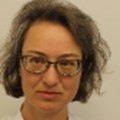Brain cancer
Radiotherapy (RT) is an important part of oncological treatment of patients with malignant and benign brain tumours. Some achieve complete cure, others prolonged survival or symptom relief. Unfortunately, irradiation of healthy brain may result in severe and persistent toxicity. As patients with lower grade gliomas or other benign tumours have prolonged survival, an increasing number of these patients experience neurocognitive impairment, the most concerning and progressive long-term toxicity, which affects quality of life. Novel RT techniques may reduce morbidity; however, information on which parts of the brain that should be spared is currently unknown. As a large proportion of future brain tumour patients will receive treatment at The Danish Center for Particle Therapy we need detailed information on radiation related parameters relevant for outcome and morbidity to plan proton and photon therapy optimally. Collecting long term follow up data is therefore crucial in these patients.

IP 2.1 Morbidity and failure database
Background
Proton beam radiotherapy (PBRT) can improve local control and reduce long term side effects. Morbidity after brain RT (neurocognition, fatigue, depression, endocrine dysfunction, steroids etc.) is related to several clinical parameters. Knowledge regarding these relations and clinical evidence proving the dosimetric advantage of PBRT is very limited. As many patients with brain tumours will become long-term survivors these data are highly needed. Patient Reported Outcome Measures (PROM) will provide supplementary information on quality of life (QoL) and daily functioning of patients.
Aim
To establish the Adults Proton and Photons Registry (APPR) for prospective and systematic data collection (survival, morbidity, PROMs. Data will be used to evaluate benefits of PBRT (normal tissue complication probability model, NTCP) and facilitate national collaborative research.
Methods
APPR will be a web-based national database including adult patients with primary brain tumours receiving RT. Patients with gliomas are currently registered in the Danish Neuro-Oncological Register (DNOR). APPR will be linked to DNOR to avoid double registration and to implement QoL and PROMs (QLQ-C30, BN-20). CTCAE 4, RANO and NANO will be used to assess toxicity and treatment response. Clinical factors, primary treatment, and follow-up data (progression and treatment at recurrence) will be registered. Further, information on IDH1, MGMT, EGFR, ATRX, 1p/19q and p53 will be collected.
IP 2.2 Neurocognitive decline
Background
RT-related damage of the hippocampus may result in neurocognitive decline. Studies of neurocognitive function in patients who received RT for tumours close to hippocampus have revealed pronounced cognitive impairments in learning and memory. Neurocognitive domains encompass distinct types of cognitive functions and each domain (attention, memory, language, perceptual-motor function, and executive function) needs to be investigated.
Aim
To investigate the correlation between neurocognitive impairment and dose-volume parameters to pre-specified brain areas. Further; The NTCP model will be validated.
Methods
Memory assessed by HVLT-R is the primary measure. Cognitive test score changes are calculated as difference in Z-score from pre-RT value. The correlation between decline in HVLT-R and radiation dose to hippocampus will be analysed. Processing speed, attention and working memory, executive function, response inhibition, and verbal fluency will be compared with radiation dose to the pre-specified brain areas in exploratory analysis. A total of 120 patients will be included. Neurocognitive testing will be performed before RT and 1, 3 and 5 years after RT.
IP 2.3 Clinical Decision Support System
Background
Selecting patients for PBRT is challenging. Currently, there are no existing prediction models for patients with brain tumours and selection relies on physician's interpretation of clinical parameters and dose differences. A decision-making tool ensuring national consensus based on best clinical practice is strongly needed.
Aim
To quantify and model the physician decision for selecting PBRT using machine learning algorithms
Methods
A total of 60 patients will be included. Target and OAR delineations will be performed, and proton and photon plans generated. Based on patient history and a comparison of dose-volume metrics the preferred RT plan will be selected by two neuro-oncologists from each center. Severalmachine learning algorithms will be applied on a subset of patients to train different models for patient selection and then validated in a matched cohort.
IP 2.4 Radiation induced brain injury
Background
White matter damage assessed by diffusion tensor imaging (DTI) has been related to late neurocognitive dysfunction. Diffusion kurtosis imaging (DKI) quantifies microstructural changes where deviation from Gaussian diffusion is measured by mean, axial or radial kurtosis (MK, AK, RK). Recently, a fast DKI and DTI sequence with acquisition time of only 3 minutes has been proposed, which makes DKI clinically feasible.
Aim
To investigate if left hippocampus AK is a predictor for memory decline.
Methods
65 patients participating in IP 2.2 study will undergo advanced MRI before RT, 3 and 12 months after RT. Spin-echo dynamic susceptibility contrast (SE-DSC, microvasculature) and fast 1-9-9 sequence (DTI/DKI) will be done (additional scan time 6 min). The relationship between diffusion and microvascular parameters and neurocognitive decline will be analysed. A combination of extracted functional (DKI and SE-DSC) and textural features will be used to train an algorithm separating patients with and without cognitive decline. The performance of the trained algorithm will be tested and subsequently validated in a prospective cohort.
Expected results
AAPR will provide information regarding treatment toxicity, survival and morbidity (neurocognitive decline in IP 2.2). Decision making support will define the most important clinical and dosimetric parameters for the patient selection for PBRT and generate nationwide consensus until more data has been collected. Further, collected data will be used to provide a NTCP model. Several biomarkers will be evaluated.
Impact/Relevance/Ethics
As many patients with brain tumours become long-time survivors’, the knowledge of treatment outcome is highly needed. Patients with gliomas are currently registered in DNOR; however, no PROM or neurocognitive data are collected and registered. This information is crucial for optimizing RT, early onset of rehabilitation and improvement of QoL. All clinical studies will be conducted in accordance to Danish laws and Helsinki declaration and registered on www.clinicaltrials.gov. Protocols will be submitted to the regional ethics committee and The Danish Data Protection Agency will be notified.
Clinical trials
- DNOG2, ClinicalTrials.gov identifier: NCT04306432
- 2 observation studies
-
Lene Haldbo-Classen
M.D. and Ph.D student
Aarhus University Hospital![]()
-
Hans Skovgaard Poulsen
MD, DMSc, Associate Research Professor/Professor, Head Neurooncology and Department of Radiation Biology
Rigshospitalet, Copenhagen![]()
-
Morten Høyer
Chief physician, professor
Aarhus University Hospital![]()
-
Christian Rønn Hansen
Radiofysisk Laboratorium & DCPT
Odense University Hospital![]()
-
Jesper Kallehauge
Ph.D.
Aarhus University Hospital![]()
-
Rikke Dahlrot
Læge, phd
Odense University Hospital![]()
-
Aida Muhic
Overlæge
Rigshospitalet, Copenhagen![]()
-
Charlotte Haslund
Overlæge
Aalborg University Hospital![]()
-
Slavka Lukacova
MD, PhD
Aarhus University Hospital![]()
-
Ali Amidi
PhD, Lektor
Aarhus University Hospital![]()









